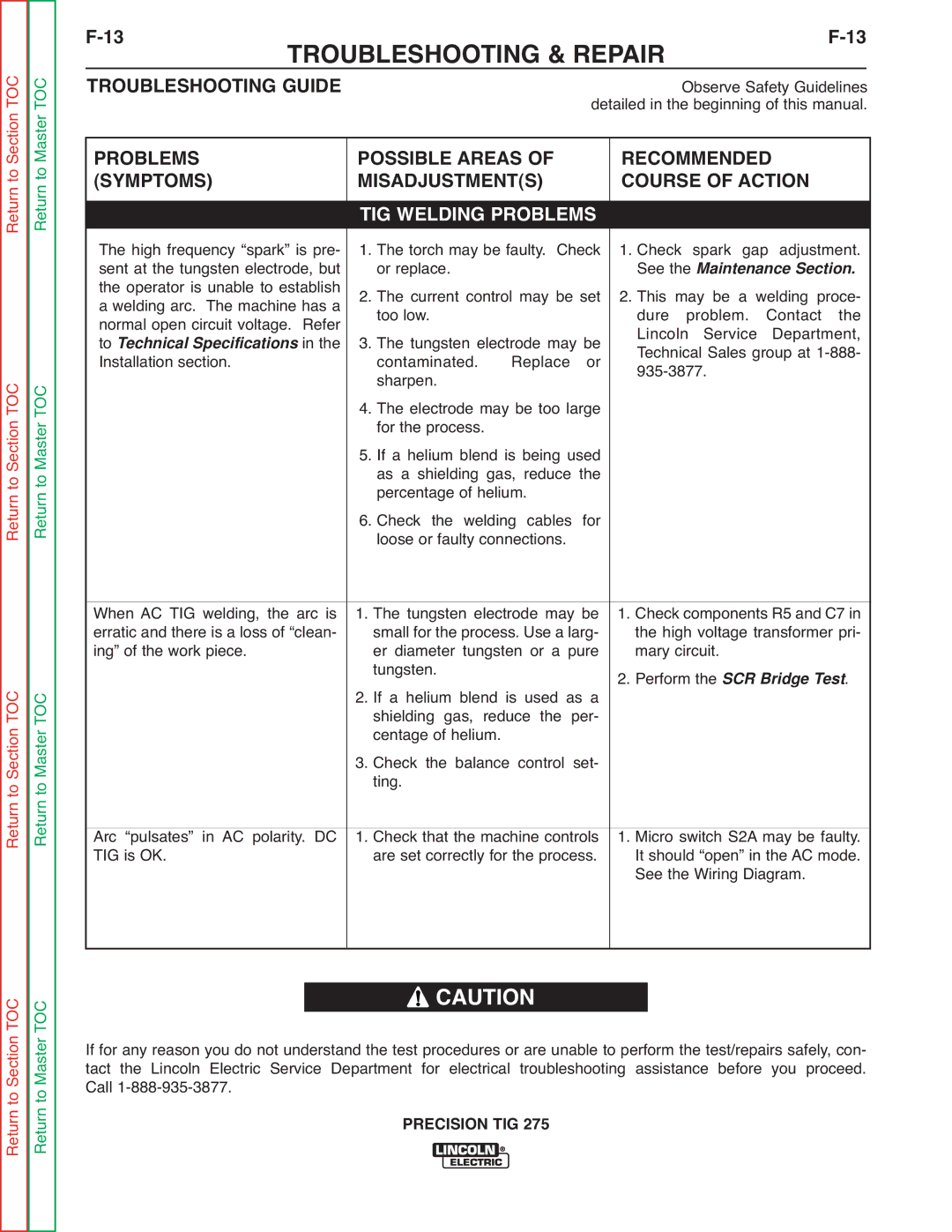
Return to Section TOC Return to Master TOC
Return to Section TOC Return to Master TOC
Return to Section TOC Return to Master TOC
TROUBLESHOOTING & REPAIR |
|
| |||||
TROUBLESHOOTING GUIDE |
|
| Observe Safety Guidelines | ||||
|
| detailed in the beginning of this manual. | |||||
PROBLEMS |
| POSSIBLE AREAS OF | RECOMMENDED |
|
| ||
|
|
| |||||
(SYMPTOMS) |
| MISADJUSTMENT(S) | COURSE OF ACTION |
| |||
|
| TIG WELDING PROBLEMS |
|
|
|
|
|
The high frequency “spark” is pre- | 1. The torch may be faulty. Check | 1. Check | spark gap | adjustment. | |||
sent at the tungsten electrode, but | or replace. | See the Maintenance Secti | n. | ||||
the operator is unable to establish | 2. The current control may be set | 2. This may be a welding proce- | |||||
a welding arc. The machine has a | |||||||
normal open circuit voltage. Refer | too low. | dure | problem. Contact | the | |||
to Technical Specifications in the | 3. The tungsten electrode may be | Lincoln Service | Department, | ||||
Installation section. |
| contaminated. Replace or | Technical Sales group at | ||||
|
| sharpen. |
|
|
| ||
|
| 4. The electrode may be too large |
|
|
|
|
|
|
| for the process. |
|
|
|
|
|
|
| 5. If a helium blend is being used |
|
|
|
|
|
|
| as a shielding gas, reduce the |
|
|
|
|
|
|
| percentage of helium. |
|
|
|
|
|
|
| 6. Check the welding cables for |
|
|
|
|
|
|
| loose or faulty connections. |
|
|
|
|
|
When AC TIG welding, the arc is | 1. The tungsten electrode may be | 1. Check components R5 and C7 in | |||||
erratic and there is a loss of “clean- | small for the process. Use a larg- | the high voltage transformer pri- | |||||
ing” of the work piece. |
| er diameter tungsten or a pure | mary circuit. |
|
|
| |
|
| tungsten. | 2. Perform the | SCR Bridge Test | |||
|
| 2. If a helium blend is used as a |
|
| . | ||
|
| shielding gas, reduce the per- |
|
|
|
|
|
|
| centage of helium. |
|
|
|
|
|
|
| 3. Check the balance control set- |
|
|
|
|
|
|
| ting. |
|
|
|
|
|
Arc “pulsates” in AC polarity. DC | 1. Check that the machine controls | 1. Micro switch S2A may be faulty. | |||||
TIG is OK. |
| are set correctly for the process. | It should “open” in the AC mode. | ||||
|
|
| See the Wiring Diagram. |
| |||
|
|
|
|
|
|
|
|
Return to Section TOC Return to Master TOC
![]() CAUTION
CAUTION
If for any reason you do not understand the test procedures or are unable to perform the test/repairs safely, con- tact the Lincoln Electric Service Department for electrical troubleshooting assistance before you proceed. Call
